Analyzing the Characteristics of Cloud Condensation Nuclei (CCN) in Hebei, China Using Multi-Year Observation and Reanalysis Data
Abstract
:1. Introduction
2. Data and Methodology
2.1. Station Data
2.2. Reanalysis Data
2.3. Methodology
3. Results
3.1. Diurnal Variation of NCCN
3.2. Diurnal Variation of NCCN in Winter
3.3. Factors Affecting the Diurnal Variation of NCCN
3.4. NCCN–SS Relationship
4. Conclusions and Discussion
Supplementary Materials
Author Contributions
Funding
Institutional Review Board Statement
Informed Consent Statement
Data Availability Statement
Acknowledgments
Conflicts of Interest
References
- Twomey, S. Pollution and the planetary albedo. Atmos. Environ. 1974, 8, 1251–1256. [Google Scholar] [CrossRef]
- Twomey, S. The Influence of Pollution on the Shortwave Albedo of Clouds. J. Atmos. Sci. 1977, 34, 1149–1152. [Google Scholar] [CrossRef] [Green Version]
- Peng, Y.; Lohmann, U.; Leaitch, R.; Banic, C.; Couture, M. The cloud albedo-cloud droplet effective radius relationship for clean and polluted clouds from RACE and FIRE.ACE. J. Geophys. Res. Atmos. 2002, 107, AAC1-1–AAC1-6. [Google Scholar] [CrossRef]
- Lohmann, U.; Feichter, J. Global indirect aerosol effects: A review. Atmos. Chem. Phys. 2005, 5, 715–737. [Google Scholar] [CrossRef] [Green Version]
- Albrecht, B.A. Aerosols, Cloud Microphysics, and Fractional Cloudiness. Science 1989, 245, 1227–1230. [Google Scholar] [CrossRef]
- Forster, P.; Storelvmo, T.; Armour, K.; Collins, W.; Dufresne, J.L.; Frame, D.; Lunt, D.J.; Mauritsen, T.; Palmer, M.D.; Watanabe, M. Climate Change 2021: The Physical Science Basis. Contribution of Working Group I to the Sixth Assessment Report of the Intergovernmental Panel on Climate Change. In Climate Change 2021: The Physical Science Basis. Contribution of Working Group I to the Sixth Assessment Report of the Intergovernmental Panel on Climate Change; Cambridge University Press: Cambridge, UK, 2021. [Google Scholar]
- Wang, M.; Peng, Y.; Liu, Y. Contrasting Aerosol Effects on Long-Wave Cloud Forcing in South East Asia and Amazon Simulated With Community Atmosphere Model Version 5.3. J. Geophys. Res. Atmos. 2020, 125, e2020JD032380. [Google Scholar] [CrossRef]
- Xu, L.; Peng, Y.; Ram, K.; Zhang, Y.; Bao, M.; Wei, J. Investigation of the Uncertainties of Simulated Optical Properties of Brown Carbon at Two Asian Sites Using a Modified Bulk Aerosol Optical Scheme of the Community Atmospheric Model Version 5.3. J. Geophys. Res. Atmos. 2021, 126, e2020JD033942. [Google Scholar] [CrossRef]
- Lee, T.-F.D.; Jiusto, J.E. Diurnal variations in cloud condensation nuclei. J. Geophys. Res. 1974, 79, 5651–5656. [Google Scholar] [CrossRef]
- Sihto, S.-L.; Mikkilä, J.; Vanhanen, J.; Ehn, M.; Liao, L.; Lehtipalo, K.; Aalto, P.P.; Duplissy, J.; Petäjä, T.; Kerminen, V.-M.; et al. Seasonal variation of CCN concentrations and aerosol activation properties in boreal forest. Atmos. Chem. Phys. 2011, 11, 13269–13285. [Google Scholar] [CrossRef] [Green Version]
- Leng, C.; Cheng, T.; Chen, J.; Zhang, R.; Tao, J.; Huang, G.; Zha, S.; Zhang, M.; Fang, W.; Li, X.; et al. Measurements of surface cloud condensation nuclei and aerosol activity in downtown Shanghai. Atmos. Environ. 2013, 69, 354–361. [Google Scholar] [CrossRef]
- Dong, X.; Xi, B.; Wu, P. Investigation of the Diurnal Variation of Marine Boundary Layer Cloud Microphysical Properties at the Azores. J. Clim. 2014, 27, 8827–8835. [Google Scholar] [CrossRef]
- Kim, J.H.; Yum, S.S.; Shim, S.; Kim, W.J.; Park, M.; Kim, J.-H.; Kim, M.-H.; Yoon, S.-C. On the submicron aerosol distributions and CCN number concentrations in and around the Korean Peninsula. Atmos. Chem. Phys. 2014, 14, 8763–8779. [Google Scholar] [CrossRef] [Green Version]
- Duan, J.; Chen, Y.; Guo, X. Characteristics of aerosol activation efficiency and aerosol and CCN vertical distributions in North China. Acta Meteorol. Sin. 2012, 26, 579–596. [Google Scholar] [CrossRef]
- Duan, J.; Lou, X.; Chen, Y.; Gao, Y.; Li, X.; Zhou, R.; Mao, H.; Lu, G.; Wang, H.; Lin, J. Aircraft measurements of aerosol vertical distributions and its activation efficiency over the Pearl River Delta. J. Appl. Meteor Sci. 2019, 30, 677–689. [Google Scholar] [CrossRef]
- Bhattu, D.; Tripathi, S.N. CCN closure study: Effects of aerosol chemical composition and mixing state. J. Geophys. Res. Atmos. 2015, 120, 766–783. [Google Scholar] [CrossRef]
- Feng, Q.; Li, Y.; Li, P.; Shen, D.; Jin, L.; Yang, J.; Sun, H. Ground observation of microphysical properties in Shanxi Province. Clim. Environ. Res. 2012, 17, 727–739. [Google Scholar] [CrossRef]
- Wang, T.; An, L.; Sun, J.; Shen, X.; Zhang, X.; Yan, P.; Deng, Z.; Liang, W.; Zhang, Y.; Chen, L. Variation Characteristics of Cloud Condensation Nuclei at Wuqing. Meteorol. Sci. Technol. 2012, 40, 466–473. [Google Scholar] [CrossRef]
- Li, Q.; Yin, Y.; Gu, X.; Yuan, L.; Kong, S.; Jiang, Q.; Chen, K.; Li, L. An observational study of aerosol hygroscopic growth factor and cloud condensation nuclei in Nanjing. China Environ. Sci. 2015, 35, 337–346. [Google Scholar]
- Logan, T.; Dong, X.; Xi, B. Aerosol properties and their impacts on surface CCN at the ARM Southern Great Plains site during the 2011 Midlatitude Continental Convective Clouds Experiment. Adv. Atmos. Sci. 2018, 35, 224–233. [Google Scholar] [CrossRef]
- Li, Y.; Zhang, F.; Li, Z.; Sun, L.; Wang, Z.; Li, P.; Sun, Y.; Ren, J.; Wang, Y.; Cribb, M.; et al. Influences of aerosol physiochemical properties and new particle formation on CCN activity from observation at a suburban site of China. Atmos. Res. 2017, 188, 80–89. [Google Scholar] [CrossRef]
- Chen, J.; Li, Z.; Lv, M.; Wang, Y.; Wang, W.; Zhang, Y.; Wang, H.; Yan, X.; Sun, Y.; Cribb, M. Aerosol hygroscopic growth, contributing factors, and impact on haze events in a severely polluted region in northern China. Atmos. Chem. Phys. 2019, 19, 1327–1342. [Google Scholar] [CrossRef] [Green Version]
- Zhang, F.; Li, Z.; Li, Y.; Sun, Y.; Wang, Z.; Li, P.; Sun, L.; Wang, P.; Cribb, M.; Zhao, C.; et al. Impacts of organic aerosols and its oxidation level on CCN activity from measurement at a suburban site in China. Atmos. Chem. Phys. 2016, 16, 5413–5425. [Google Scholar] [CrossRef] [Green Version]
- Shi, L.; Duan, Y. Observations of Cloud Condensation Nuclei in North China. Acta Meteorol. Sin. 2007, 65, 97–106. [Google Scholar]
- Yue, Y.; Niu, S.; Sang, J.; Lv, J. Observational study on the distribution of cloud condensation nuclei and its causes in drought region. China Environ. Sci. 2010, 30, 593–598. [Google Scholar]
- Liu, J.; Zheng, Y.; Li, Z.; Cribb, M. Analysis of cloud condensation nuclei properties at a polluted site in southeastern China during the AMF-China Campaign. J. Geophys. Res. 2011, 116, D00K35. [Google Scholar] [CrossRef] [Green Version]
- Feng, Q.; Li, P.; Fan, M.; Hou, T. Observational analysis of cloud condensation nuclei in some regions of North China. Trans. Atmos. Sci. 2012, 35, 533–540. [Google Scholar] [CrossRef]
- Hsiao, T.-C.; Ye, W.-C.; Wang, S.-H.; Tsay, S.-C.; Chen, W.-N.; Lin, N.-H.; Lee, C.-T.; Hung, H.-M.; Chuang, M.-T.; Chantara, S. Investigation of the CCN Activity, BC and UVBC Mass Concentrations of Biomass Burning Aerosols during the 2013 BASELInE Campaign. Aerosol Air Qual. Res. 2016, 16, 2742–2756. [Google Scholar] [CrossRef] [Green Version]
- Zhao, Y.; Niu, S.; Lv, J.; Xu, J.; Sang, J. Observational Analyses on Cloud Condensation Nuclei in Northwestern China in Summer of 2007. Plateau Meteorol. 2010, 29, 1043–1049. [Google Scholar]
- Qi, J.; Yao, X. Observation Analysis of Cloud Condensation Nuclei over Qingdao in Winter. Period. Ocean Univ. 2019, 48, 10–19. [Google Scholar]
- Che, H.C.; Zhang, X.Y.; Wang, Y.Q.; Zhang, L.; Shen, X.J.; Zhang, Y.M.; Ma, Q.L.; Sun, J.Y.; Zhang, Y.W.; Wang, T.T. Characterization and parameterization of aerosol cloud condensation nuclei activation under different pollution conditions. Sci. Rep. 2016, 6, 24497. [Google Scholar] [CrossRef]
- Jurányi, Z.; Gysel, M.; Weingartner, E.; Bukowiecki, N.; Kammermann, L.; Baltensperger, U. A 17 month climatology of the cloud condensation nuclei number concentration at the high alpine site Jungfraujoch. J. Geophys. Res. Atmos. 2011, 116, D10204. [Google Scholar] [CrossRef]
- Pöhlker, M.L.; Pöhlker, C.; Ditas, F.; Klimach, T.; De Angelis, I.H.; Araújo, A.; Brito, J.; Carbone, S.; Cheng, Y.; Chi, X.; et al. Long-term observations of cloud condensation nuclei in the Amazon rain forest—Part 1: Aerosol size distribution, hygroscopicity, and new model parametrizations for CCN prediction. Atmos. Chem. Phys. 2016, 16, 15709–15740. [Google Scholar] [CrossRef] [Green Version]
- Schmale, J.; Henning, S.; Decesari, S.; Henzing, B.; Keskinen, H.; Sellegri, K.; Ovadnevaite, J.; Pöhlker, M.; Brito, J.; Bougiatioti, A.; et al. Long-term cloud condensation nuclei number concentration, particle number size distribution and chemical composition measurements at regionally representative observatories. Atmos. Chem. Phys. 2018, 18, 2853–2881. [Google Scholar] [CrossRef] [Green Version]
- Frank, C.W.; Wahl, S.; Keller, J.D.; Pospichal, B.; Hense, A.; Crewell, S. Bias correction of a novel European reanalysis data set for solar energy applications. Sol. Energy 2018, 164, 12–24. [Google Scholar] [CrossRef]
- Jiang, H.; Yang, Y.; Bai, Y.; Wang, H. Evaluation of the Total, Direct, and Diffuse Solar Radiations from the ERA5 Reanalysis Data in China. IEEE Geosci. Remote Sens. Lett. 2020, 17, 47–51. [Google Scholar] [CrossRef]
- Mahto, S.S.; Mishra, V. Does ERA-5 Outperform Other Reanalysis Products for Hydrologic Applications in India? J. Geophys. Res. Atmos. 2019, 124, 9423–9441. [Google Scholar] [CrossRef]
- Chen, S.; Gan, T.Y.; Tan, X.; Shao, D.; Zhu, J. Assessment of CFSR, ERA-Interim, JRA-55, MERRA-2, NCEP-2 reanalysis data for drought analysis over China. Clim. Dyn. 2019, 53, 737–757. [Google Scholar] [CrossRef]
- Twomey, S. The nuclei of natural cloud formation part II: The supersaturation in natural clouds and the variation of cloud droplet concentration. Geofis. Pura Appl. 1959, 43, 243–249. [Google Scholar] [CrossRef]
- Hudson, J.G. Relationship between fog condensation nuclei and fog microstructure. J. Atmos. Sci. 1980, 37, 1854–1867. [Google Scholar] [CrossRef] [Green Version]
- Martins, J.A.; Gonçalves, F.L.T.; Morales, C.A.; Fisch, G.F.; Pinheiro, F.G.M.; Leal, B.V., Jr.; Oliveira, C.J.; Silva, E.M.; Oliveira, J.C.P.; Costa, A.A.; et al. Cloud condensation nuclei from biomass burning during the Amazonian dry-to-wet transition season. Meteorol. Atmos. Phys. 2009, 104, 83–93. [Google Scholar] [CrossRef]
- Huang, J.; Pan, X.; Guo, X.; Li, G. Health impact of China’s Air Pollution Prevention and Control Action Plan: An analysis of national air quality monitoring and mortality data. Lancet Planet. Health 2018, 2, e313–e323. [Google Scholar] [CrossRef] [Green Version]
- Cai, S.; Wang, Y.; Zhao, B.; Wang, S.; Chang, X.; Hao, J. The impact of the “Air Pollution Prevention and Control Action Plan” on PM2.5 concentrations in Jing-Jin-Ji region during 2012–2020. Sci. Total Environ. 2017, 580, 197–209. [Google Scholar] [CrossRef] [PubMed]
- Sogacheva, L.; De Leeuw, G.; Rodriguez, E.; Kolmonen, P.; Georgoulias, A.K.; Alexandri, G.; Kourtidis, K.; Proestakis, E.; Marinou, E.; Amiridis, V.; et al. Spatial and seasonal variations of aerosols over China from two decades of multi-satellite observations -Part 1: ATSR (1995–2011) and MODiS C6.1 (2000–2017). Atmos. Chem. Phys. 2018, 18, 11389–11407. [Google Scholar] [CrossRef] [Green Version]
- Wei, J.; Peng, Y.; Mahmood, R.; Sun, L.; Guo, J. Intercomparison in spatial distributions and temporal trends derived from multi-source satellite aerosol products. Atmos. Chem. Phys. 2019, 19, 7183–7207. [Google Scholar] [CrossRef] [Green Version]
- Qu, X.; Fu, G.; Jia, J.; Yang, G. Distribution characteristics of air quality and its relationship with meteorological factors from 2005 to 2009 in Shijiazhuang, Hebei province. J. Meteorol. Environ. 2011, 27, 29–32. [Google Scholar]
- Xu, W.Y.; Zhao, C.S.; Ran, L.; Deng, Z.Z.; Liu, P.F.; Ma, N.; Lin, W.L.; Xu, X.B.; Yan, P.; He, X.; et al. Characteristics of pollutants and their correlation to meteorological conditions at a suburban site in the North China Plain. Atmos. Chem. Phys. 2011, 11, 4353–4369. [Google Scholar] [CrossRef] [Green Version]
- Roberts, G.C.; Nenes, A. A continuous-flow streamwise thermal-gradient CCN chamber for atmospheric measurements. Aerosol Sci. Technol. 2005, 39, 206–221. [Google Scholar] [CrossRef]
- Ward, D.S.; Cotton, W.R. Cold and transition season cloud condensation nuclei measurements in western Colorado. Atmos. Chem. Phys. 2011, 11, 4303–4317. [Google Scholar] [CrossRef] [Green Version]
- Gelaro, R.; McCarty, W.; Suárez, M.J.; Todling, R.; Molod, A.; Takacs, L.; Randles, C.A.; Darmenov, A.; Bosilovich, M.G.; Reichle, R.; et al. The Modern-Era Retrospective Analysis for Research and Applications, Version 2 (MERRA-2). J. Clim. 2017, 30, 5419–5454. [Google Scholar] [CrossRef]
- Xing, Z.; Li, S.; Xiong, Y.; Du, K. Estimation of cross-boundary aerosol flux over the Edmonton-Calgary Corridor in Canada based on CALIPSO and MERRA-2 data during 2011–2017. Atmos. Environ. 2021, 246, 118084. [Google Scholar] [CrossRef]
- Sun, E.; Che, H.; Xu, X.; Wang, Z.; Lu, C.; Gui, K.; Zhao, H.; Zheng, Y.; Wang, Y.; Wang, H.; et al. Variation in MERRA-2 aerosol optical depth over the Yangtze River Delta from 1980 to 2016. Theor. Appl. Climatol. 2019, 136, 363–375. [Google Scholar] [CrossRef]
- McCoy, D.T.; Bender, F.A.-M.; Mohrmann, J.K.C.; Hartmann, D.L.; Wood, R.; Grosvenor, D.P. The global aerosol-cloud first indirect effect estimated using MODIS, MERRA, and AeroCom. J. Geophys. Res. Atmos. 2017, 122, 1779–1796. [Google Scholar] [CrossRef]
- Zhao, Q.; Zhao, W.; Bi, J.; Ma, Z. Climatology and calibration of MERRA-2 PM2.5 components over China. Atmos. Pollut. Res. 2021, 12, 357–366. [Google Scholar] [CrossRef]
- Ma, X.; Yan, P.; Zhao, T.; Jia, X.; Jiao, J.; Ma, Q.; Wu, D.; Shu, Z.; Sun, X.; Habtemicheal, B.A. Article evaluations of surface pm10 concentration and chemical compositions in merra-2 aerosol reanalysis over central and eastern China. Remote Sens. 2021, 13, 1317. [Google Scholar] [CrossRef]
- Qin, W.; Zhang, Y.; Chen, J.; Yu, Q.; Cheng, S.; Li, W.; Liu, X.; Tian, H. Variation, sources and historical trend of black carbon in Beijing, China based on ground observation and MERRA-2 reanalysis data. Environ. Pollut. 2019, 245, 853–863. [Google Scholar] [CrossRef] [PubMed]
- Wang, Q.; Li, W.; Xiao, C.; Ai, W. Evaluation of high-resolution crop model meteorological forcing datasets at regional scale: Air temperature and precipitation over major land areas of China. Atmosphere 2020, 11, 1011. [Google Scholar] [CrossRef]
- Jiang, Y.; Han, S.; Shi, C.; Gao, T.; Zhen, H.; Liu, X. Evaluation of HRCLDAS and ERA5 Datasets for Near-Surface Wind over Hainan Island and South China Sea. Atmosphere 2021, 12, 766. [Google Scholar] [CrossRef]
- Benesty, J.; Chen, J.; Huang, Y.; Speech, I.C.-N. Pearson Correlation Coefficient. In Noise Reduction in Speech Processing; Springer: Berlin/Heidelberg, Germany, 2009. [Google Scholar]
- Zhang, F.; Wang, Y.; Peng, J.; Ren, J.; Collins, D.; Zhang, R.; Sun, Y.; Yang, X.; Li, Z. Uncertainty in Predicting CCN Activity of Aged and Primary Aerosols. J. Geophys. Res. Atmos. 2017, 122, 11723–11736. [Google Scholar] [CrossRef]
- Wang, Y.; Zhang, F.; Li, Z.; Tan, H.; Xu, H.; Ren, J.; Zhao, J.; Du, W.; Sun, Y. Enhanced hydrophobicity and volatility of submicron aerosols under severe emission control conditions in Beijing. Atmos. Chem. Phys. 2017, 17, 5239–5251. [Google Scholar] [CrossRef] [Green Version]
- Duan, X.; Jiang, Y.; Wang, B.; Zhao, X.; Shen, G.; Cao, S.; Huang, N.; Qian, Y.; Chen, Y.; Wang, L. Household fuel use for cooking and heating in China: Results from the first Chinese Environmental Exposure-Related Human Activity Patterns Survey (CEERHAPS). Appl. Energy 2014, 136, 692–703. [Google Scholar] [CrossRef]
- Chai, L.; Ma, C.; Ni, J.Q. Performance evaluation of ground source heat pump system for greenhouse heating in northern China. Biosyst. Eng. 2012, 111, 107–117. [Google Scholar] [CrossRef]
- Liu, H.; He, K.; Barth, M. Traffic and emission simulation in China based on statistical methodology. Atmos. Environ. 2011, 45, 1154–1161. [Google Scholar] [CrossRef]
- Kublanovskaya, V.N. On some algorithms for the solution of the complete eigenvalue problem. USSR Comput. Math. Math. Phys. 1962, 1, 637–657. [Google Scholar] [CrossRef]
- Hobbs, P.V.; Bowdle, D.A.; Radke, L.F. Particles in the lower troposphere over the high plains of the United States. Part II: Cloud condensation nuclei. J. Clim. Appl. Meteorol. 1985, 24, 1358–1369. [Google Scholar] [CrossRef] [Green Version]
- Miao, Q.; Zhang, Z.; Li, Y.; Qin, X.; Xu, B.; Yuan, Y.; Gao, Z. Measurement of cloud condensation nuclei (CCN) and CCN closure at Mt. Huang based on hygroscopic growth factors and aerosol number-size distribution. Atmos. Environ. 2015, 113, 127–134. [Google Scholar] [CrossRef]
- Dou, X.; Liao, C.; Wang, H.; Huang, Y.; Tu, Y.; Huang, X.; Peng, Y.; Zhu, B.; Tan, J.; Deng, Z.; et al. Estimates of daily ground-level NO2 concentrations in China based on Random Forest model integrated K-means. Adv. Appl. Energy 2021, 2, 100017. [Google Scholar] [CrossRef]
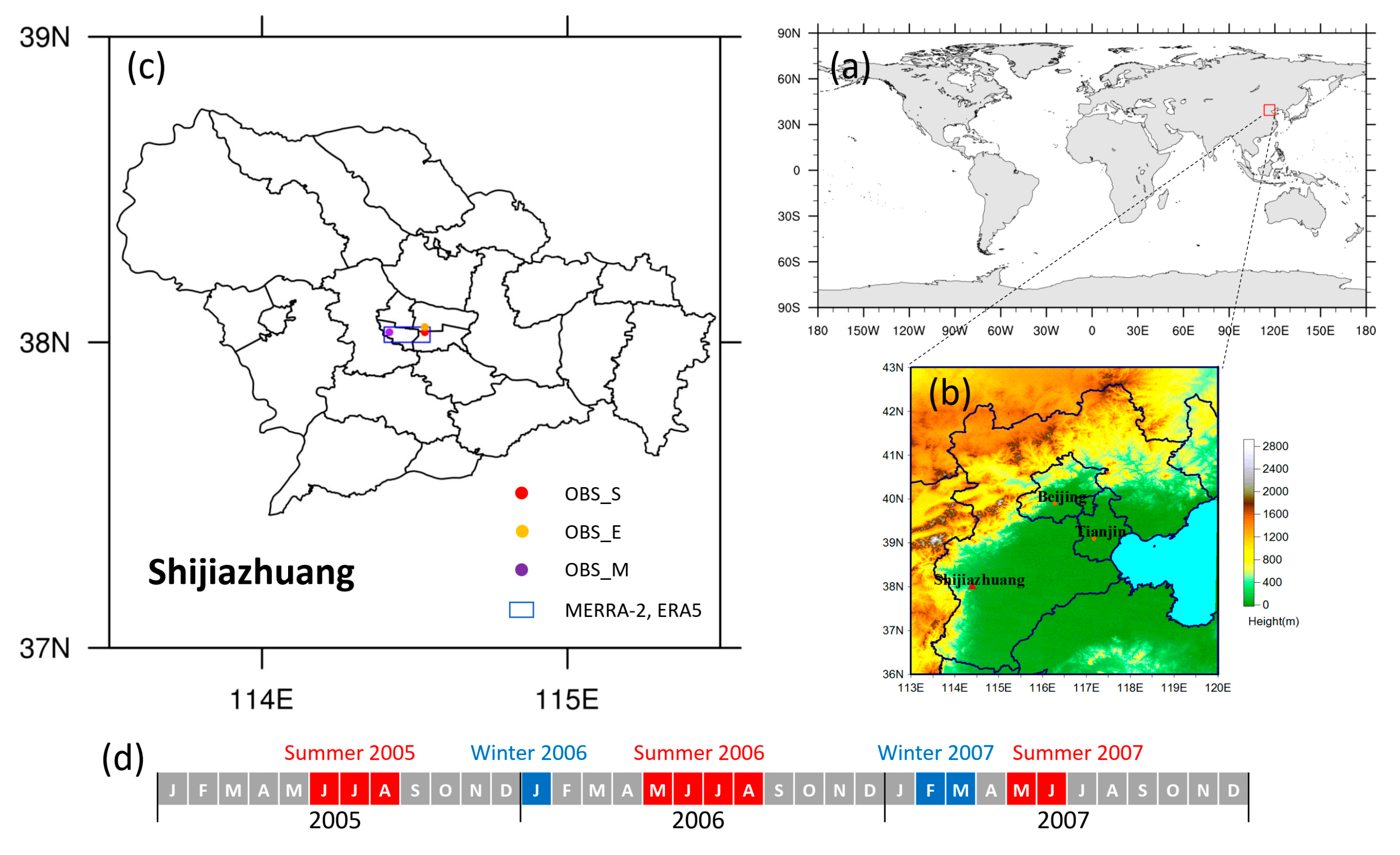
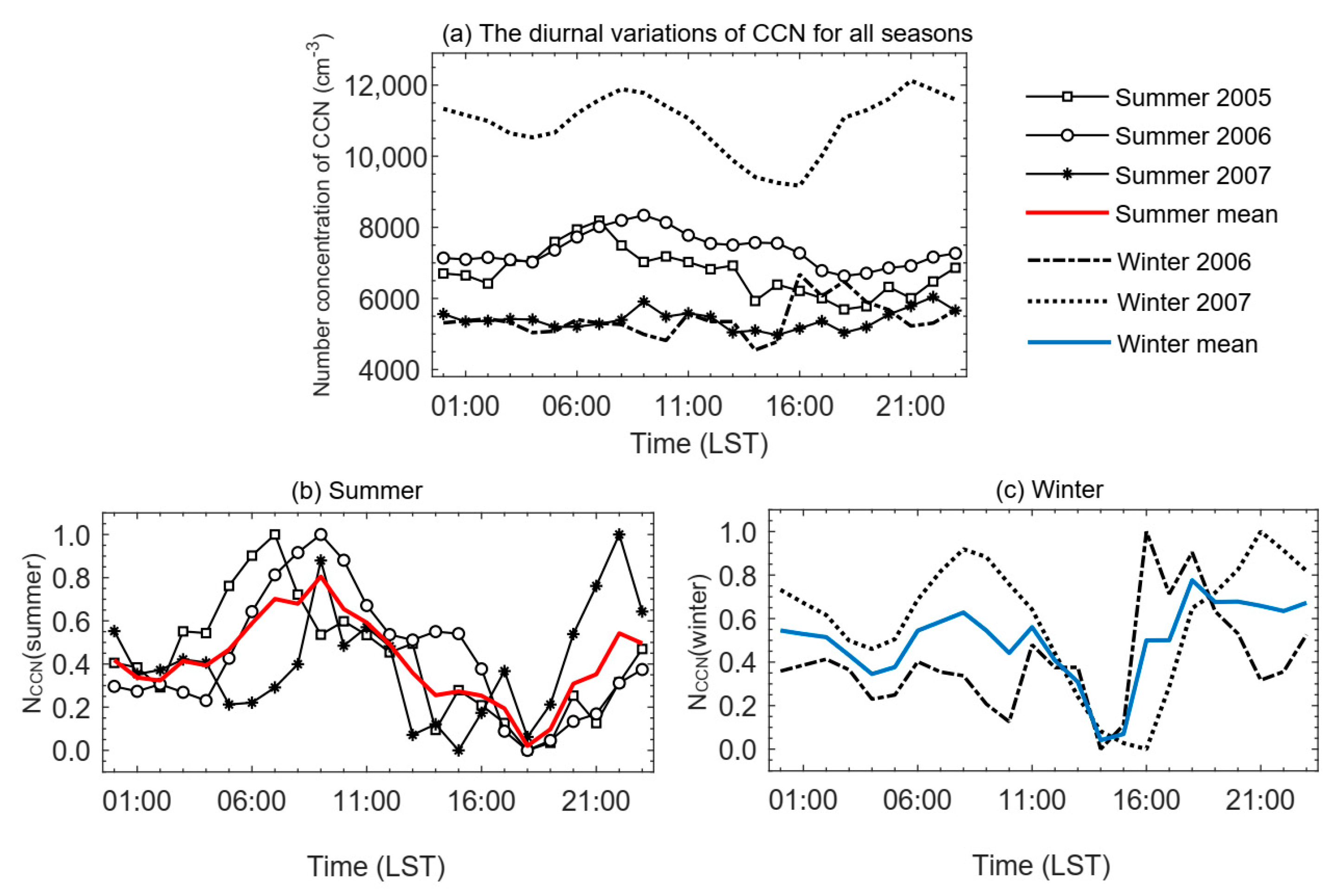

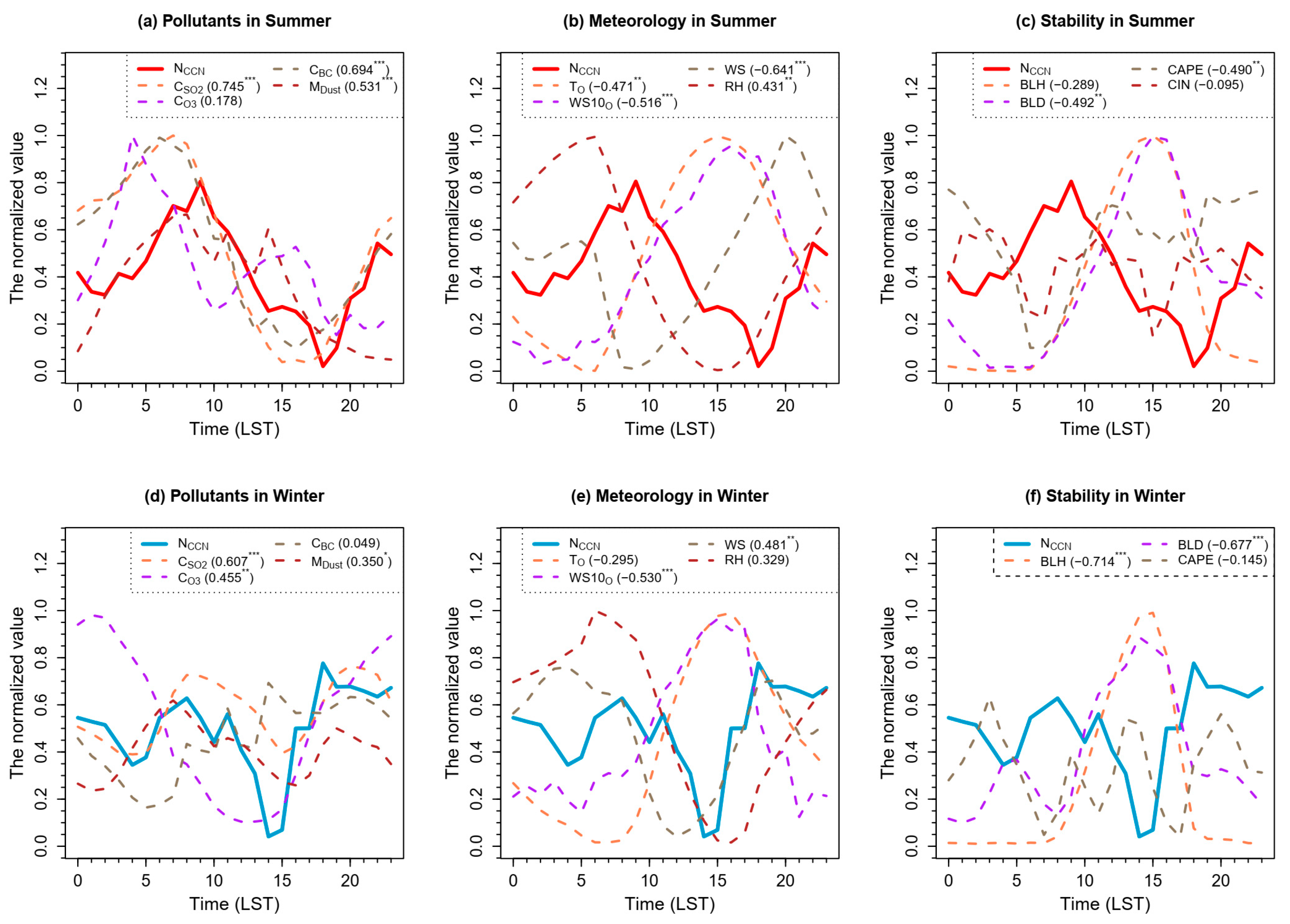
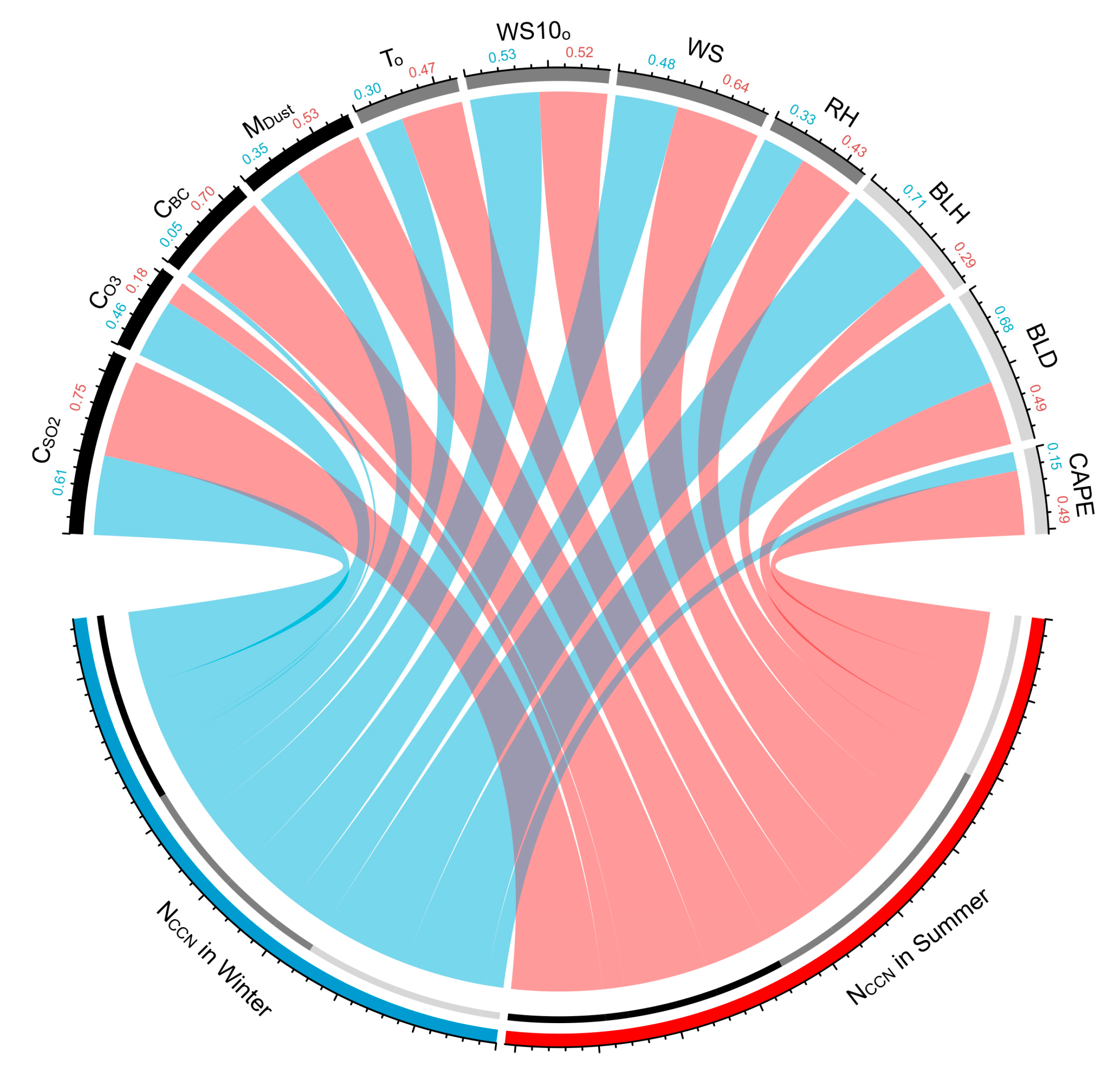
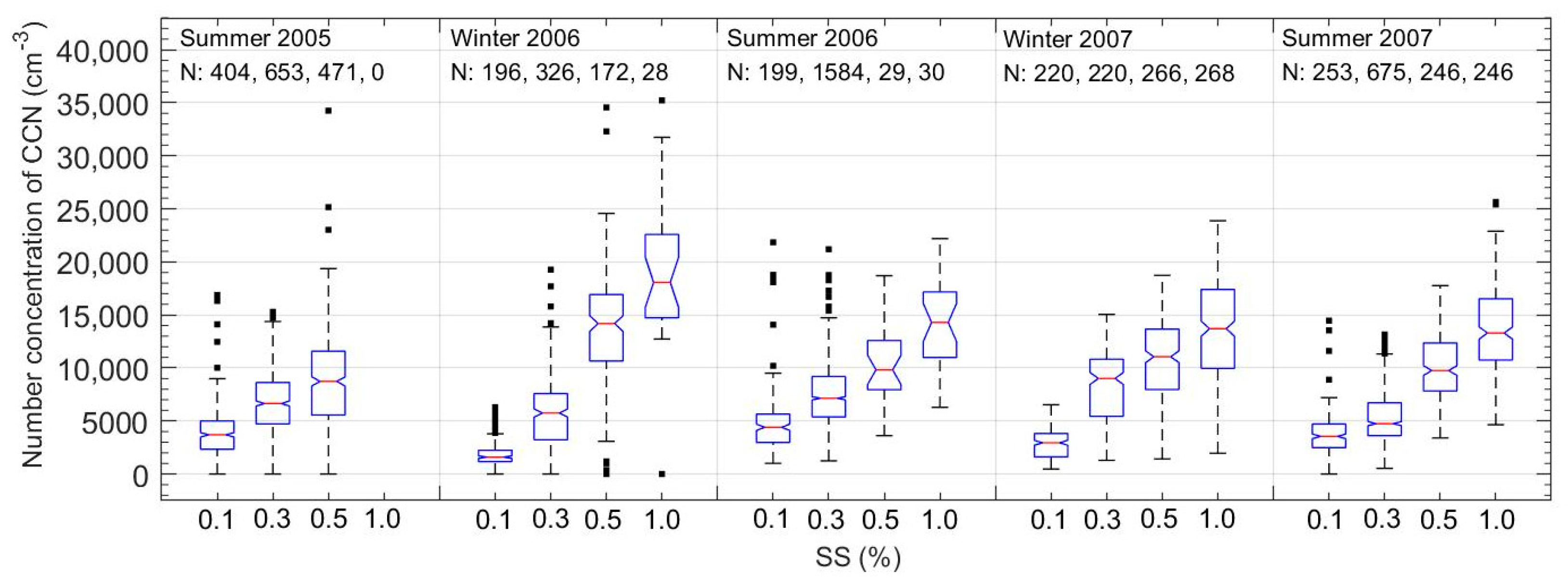
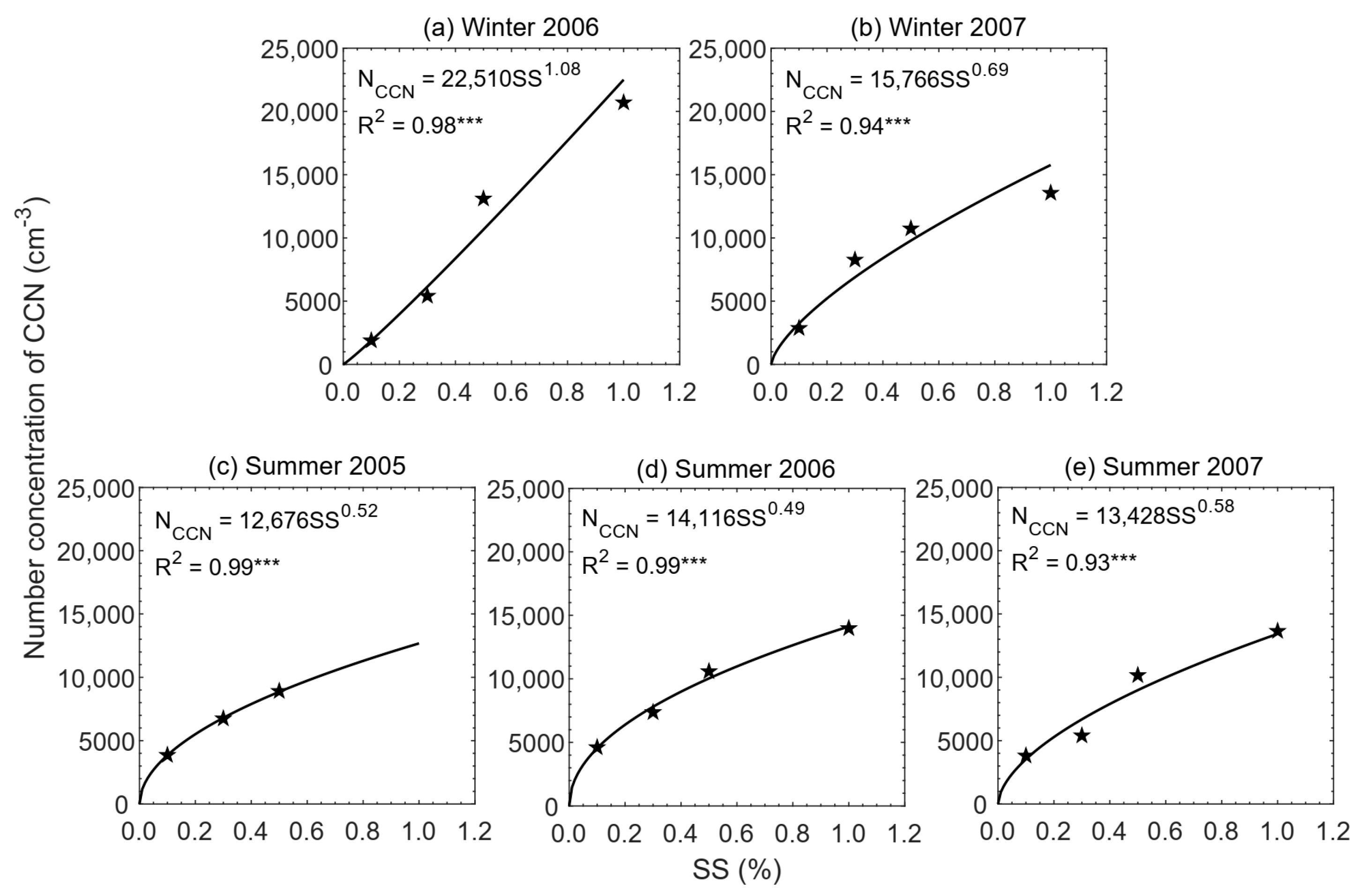
| Variable | Description | Unit | Data Source | Time |
|---|---|---|---|---|
| OBS_E | 28 February 2007–12 March 2007 (winter 2007) | |||
| OBS_E | ||||
| OBS_E | ||||
| The number concentration of CCN | OBS_S | 24 June 2005–9 August 2005 (summer 2005), 1 January 2006–19 January 2006 (winter 2006) 21 May 2006–19 August 2006 (summer 2006), 28 February 2007–12 March 2007 (winter 2007), and 24 May 2007–30 June 2007 (summer 2007) | ||
| Surface mass concentration of dust | MERRA-2 | |||
| MERRA-2 | ||||
| Total column concentration of ozone | DU | MERRA-2 | ||
| Column mass concentration of black carbon | MERRA-2 | |||
| Temperature | K | MERRA-2, | ||
| Temperature | K | OBS-M, | ||
| Temperature | K | ERA5 | ||
| 10 m wind speed | MERRA-2, | |||
| 10 m wind speed | OBS-M, | |||
| 10 m wind speed | ERA5 | |||
| Relative humidity | % | ERA5 | ||
| Surface wind speed | MERRA-2 | |||
| Boundary layer height | m | ERA5 | ||
| Boundary layer dissipation | ERA5 | |||
| Convective available potential energy | ERA5 | |||
| Convective inhibition | ERA5 |
| Order | Summer | Winter | ||||
|---|---|---|---|---|---|---|
| Variable | r | p-Value | Variable | r | p-Value | |
| 1 | 0.745 *** | 0.00003 | −0.714 *** | 0.00009 | ||
| 2 | 0.694 *** | 0.00017 | −0.677 *** | 0.00028 | ||
| 3 | −0.641 *** | 0.00073 | 0.607 *** | 0.00166 | ||
| 4 | 0.531 *** | 0.00761 | −0.530 *** | 0.00778 | ||
| 5 | −0.516 *** | 0.00984 | 0.481 ** | 0.01725 | ||
| 6 | −0.492 ** | 0.01456 | 0.455 ** | 0.02559 | ||
| 7 | −0.490 ** | 0.01504 | 0.350 * | 0.09329 | ||
| 8 | −0.471 ** | 0.02008 | 0.329 | 0.11667 | ||
| 9 | 0.431 ** | 0.03543 | −0.295 | 0.16123 | ||
| 10 | −0.289 | 0.17083 | −0.145 | 0.49900 | ||
| 11 | 0.178 | 0.40573 | 0.049 | 0.82153 | ||
| 12 | −0.095 | 0.65769 | -- | -- | ||
| Reference | Time | Type | Location | ||
|---|---|---|---|---|---|
| Twomey [39] | Spring, 1958 | 2000 | 0.40 | Transitional | Australia |
| Hudson [40] | Autumn, 1976 | 2500 | 0.70 | Continental | San Diego, CA, USA |
| Martins et al. [41] | Autumn, 2002 | 2220 | 1.28 | / | Amazonia, Brazil |
| Wang et al. [18] | Autumn, 2012 | 4230~17,752 | 0.49~0.69 | Continental | Tianjin, China |
| Qi and Yao [30] | Winter, 2017 | 4982~11,689 | 0.51~0.72 | Continental | Qingdao, China |
| Miao et al. [67] | Summer, 2014 | 1932 | 0.53 | Transitional | Huangshan, China |
| This work | Summer, 2005~2007 | 12,676~14,116 | 0.49~0.58 | Continental | Shijiazhuang, China |
| Winter, 2006~2007 | 15,766~22,510 | 0.69~1.08 |
Publisher’s Note: MDPI stays neutral with regard to jurisdictional claims in published maps and institutional affiliations. |
© 2022 by the authors. Licensee MDPI, Basel, Switzerland. This article is an open access article distributed under the terms and conditions of the Creative Commons Attribution (CC BY) license (https://creativecommons.org/licenses/by/4.0/).
Share and Cite
Wang, H.; Zhang, M.; Peng, Y.; Duan, J. Analyzing the Characteristics of Cloud Condensation Nuclei (CCN) in Hebei, China Using Multi-Year Observation and Reanalysis Data. Atmosphere 2022, 13, 468. https://doi.org/10.3390/atmos13030468
Wang H, Zhang M, Peng Y, Duan J. Analyzing the Characteristics of Cloud Condensation Nuclei (CCN) in Hebei, China Using Multi-Year Observation and Reanalysis Data. Atmosphere. 2022; 13(3):468. https://doi.org/10.3390/atmos13030468
Chicago/Turabian StyleWang, Hengqi, Meng Zhang, Yiran Peng, and Jing Duan. 2022. "Analyzing the Characteristics of Cloud Condensation Nuclei (CCN) in Hebei, China Using Multi-Year Observation and Reanalysis Data" Atmosphere 13, no. 3: 468. https://doi.org/10.3390/atmos13030468






